B-29 Superfortress Bockscar ... S/N 44-87627
The United States built near 4,000 B-29s for the war effort in the early 1940s. A total of only about 22 complete B-29 airplanes have survivied, been preserved, and are currently on display in the United States. Only one is airworthy condition, "FiFi".
This is the story of another B-29 survivor ... "Bockscar".
The 509th Composite Group
The 509th Composite Group was created in September of 1944 when Major General Leslie Groves, head of the Manhattan Project building the atomic bomb, saw the need for a dedicated group of airmen trained to drop the bomb on targets in Japan, and return safely to U.S. bases.
He chose 29 year old Colonel Paul W. Tibbets, Jr. to assemble and command the group of 1,800 men.
The Silverplate Superfortresses
Late in 1944, Army Air Forces leaders selected the Glenn L. Martin Company in Omaha to produce a squadron of B-29s codenamed "Silverplate". Martin modified these Superfortresses by removing all gun turrets except for the tail position, removing armor plate, and installing Curtiss electric propellers. The bomb bay doors and the fuselage section between the bomb bays were removed to create a single 33-foot bomb bay which could accommodate either the "Fat Man" or "Little Boy" versions of the atomic bomb.
The Silverplate's four Wright 2,200 HP, R-3350-57 Cyclone engines supported a take-off weight of 67 tons fully loaded and a cruising speed of 190 to 200 miles per hour. The aircraft's ceiling was 35,000 feet, nearly seven miles above sea level.
The AAF assigned the fleet of 15 Silverplate Superfortresses to the 509th Composite Group. As the Group Commander, Tibbets had no specific aircraft assigned to him as did the mission pilots. He was entitled to fly any aircraft at any time.
The Move to Tinian and Final Bombing Plans
The Japanese Ushi Point airfield on the Pacific island of Tinian in the Marianas had fallen to United States forces on July 26, 1944. The capture of Tinian was a key part in the plan to provide a closer base for the U.S. forces to bomb Japan. Still, the distances to Japan were great, as the island lies at 1,500 miles south of Tokyo. Work on restoring and improving the airfield to support Superfortresses began immediately by Army Seabees.
Shaped like Manhattan in New York, the Army engineers named the base facilities with names like Broadway and 42nd Street. Its four parallel runways at North Field were 8,500' in length and marked as "A", "B", "C" and "D" (from north to south). Hardstands were constucted to park and maintain 265 Superfortresses. Two additional runways were built at West Field (today, known as Tinian International Airport).
In 1945, Tinian became the largest airfield in the world, occupied by 40,000 U.S. troops.
By May of 1945, the 509th had moved to Tinian. It was was assigned an area near the airfield on the north end of Tinian, several miles from the main installations where the other groups were assigned. The 509th aircraft almost always used runway "A" and the aircraft were parked away from the other groups on the north side of the runway.
On July 26, 1945, the cruiser Indianapolis dropped anchor off Tinian and unloaded a 15-foot wooden crate. Inside was the atomic bomb, complete except for a second unit of uranium that a B-29 later delivered. Four days after departing Tinian, Indianapolis was sunk by a Japanese submarine.
By August of 1945, plans for the atomic bombing missions were finalized. Seven Superfortresses would take part in each bombing run: the primary (carrying the bomb), a standby, a photo plane, one with scientific instruments to measure the blast, and three others that would scout ahead. Bombing would be visual, rather than by radar. Possible target cities included Hiroshima, Kokura, Niigata, and Nagasaki.
Bockscar Moves to the Pacific Theater in World War II One of the Silverplates, "Bockscar", a B-29A-40-MO Superfortress, S/N 44-27297, was delivered on March 19, 1945 to the U.S. Air Forces after final assembly by the Martin Company in Omaha, Nebraska.
After delivery, Bockscar was subsequently assigned to the 393d Bombardment Squadron, 509th Composite Group, at Wendover Army Air Field, Utah in April of 1945.
Crew C-13 was assigned to Bockscar, including the pilot Frederick C. Bock. The name given to the aircraft, and painted on it after the mission, was a take-off on the name of the aircraft commander.
Bockscar left Wendover on June 11, 1945 for Tinian Island in the Marianas, where it arrived on June 16. The ferry route from Utah normally included stops in California, Hawaii, and Guam. It was originally given the Victor (unit-assigned identification) number 7 but on August 1 was given the triangle N tail markings of the 444th Bombardment Group as a security measure, and had its Victor changed to 77 to avoid misidentification with an actual 444th aircraft.
Bockscar was used in 13 training and practice missions from Tinian, and three combat missions in which it dropped "pumpkin" bombs on industrial targets in Japan. The pumpkin bombs were a means of providing realistic training for later atomic bomb flights. They were a close but non-nuclear replication of the nuclear bomb with the same ballistic and handling characteristics. (See photo below for nose art markings on Bockscar indicating the pumpkin bombs it dropped)
The Day of the First Atomic Bomb Drop: August 6, 1945
Colonel Tibbets piloted the B-29 "Enola Gay" on August 6, 1945, and dropped the "Little Boy" highly enriched uranium, explosion-type, "gun-fired," atomic bomb over Hiroshima, Japan. Little Boy was anything but little, at 12 feet in length and 28 inches in diameter, and weighing 9,000 pounds.
Japan did not surrender, apparently thinking the United States had only one nuclear bomb. In fact, the U.S. had only TWO bombs, although plans were made to have others assembled by September and dropped in additional missions over Japan.
The Day the Second Bomb Dropped: August 9, 1945
A second B-29 Superfortresses flight, with Bockscar as the primary aircraft, was scheduled to bomb Kokura, Japan on August 11, 1945. But weather forced a change in the date to August 9. This second nuclear bomb run was to further decimate Japan's military structure, but also to demonstrate that the U.S. had an arsenal of nuclear weapons. "Bockscar" was to carry the bomb. The B-29 "The Great Artiste" was designated as the observation, instrumentation support plane for the mission, and another B-29, "The Big Stink" as the photographic aircraft. The two weather planes were "Enola Gay" and "Laggin' Dragon".
On August 9, 1945, Bockscar was piloted by another crew C-15 (that normally flew the B-29 "The Great Artiste") led by aircraft commander Charles W. Sweeney. Takeoff from Tinian's North Field was at 3:45 a.m.
The Great Artiste, which was the aircraft Sweeney most often flew, had originally been designated to drop the second bomb, but the aircraft had been fitted with observation instruments for the Hiroshima mission. Moving the instrumentation from The Great Artiste to Bockscar would have been a complex and time-consuming process, and when the second atomic bomb mission was moved up from August 9th to the 11th because of forecasts of bad weather, the crews of The Great Artiste and Bockscar exchanged aircraft. The result was that the bomb was carried by Bockscar, but flown by Sweeney and his C-15 crew of The Great Artiste.
The original target was Kokura, but due to cloud cover, and smoke from previous B-29 bomb raids, the target was changed to Nagasaki, 95 miles to the south, the location of two large Mitsubishi armament plants.
A short time later Bockscar successfully released the "Fat Man" highly-enriched plutonium, implosion-type atomic bomb over the city of Nagasaki. It exploded 43 seconds later with a blast yield equivalent to 21 kilotons of TNT at an altitude of 1,650 feet.
After the bombing run, Bockscar ran dangerously low on fuel, and barely made a landing at Yonton Airfield in Okinawa.
On August 14, 1945, the Japanese accepted Allied terms for unconditional surrender. Bockscar is often credited as the aircraft that indeed ended WWII.
The Fate of Bockscar After World War II
After the war end, Bockscar was flown back to the United States in November of 1945, and assigned with the 509th at Roswell Army Air Field, New Mexico. In August 1946, it was assigned to the 4105th Army Air Force Unit at Davis-Monthan Army Air Field, Arizona, for storage. It was placed on display at Davis-Monthan AFB in Tucson as "the aircraft that bombed Nagasaki" but in the markings of The Great Artiste (see photo below). In September of that year it was given to the National Museum of the United States Air Force at Wright-Patterson Air Force Base, Ohio.
After storage for years in the desert, Bockscar was flown to Dayton in September of 1961. Today, it is on display at the Museum of the United States Air Force in Dayton, Ohio in its original markings (see photos below).
Boeing B-29 Superfortress "Bockscar" in storage at Davis-Monthan AFB after World War II |
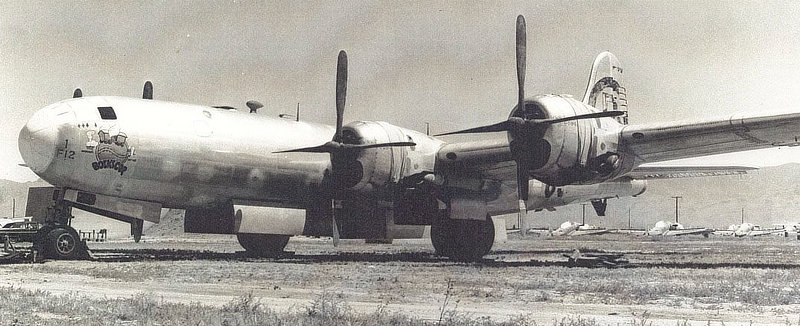 |
Other Surviving B-29 Superfortress Aircraft
click to see a complete list of surviving B-29s, their names, serial numbers, and locations
Photographs of the B-29 Superfortress "Bockscar"
B-29 Superfortress "Bockscar" at the National Museum of the U.S. Air Force in Dayton, Ohio |
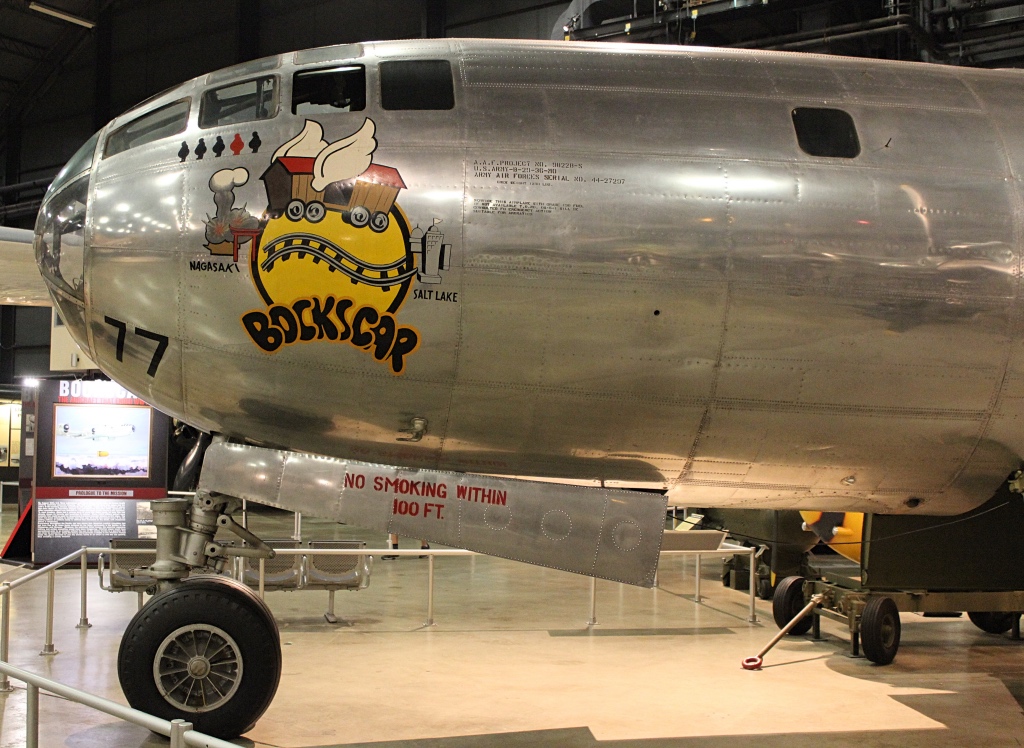 |
B-29 Superfortress "Bockscar" with a mockup of the "Fat Man" bomb alongside, |
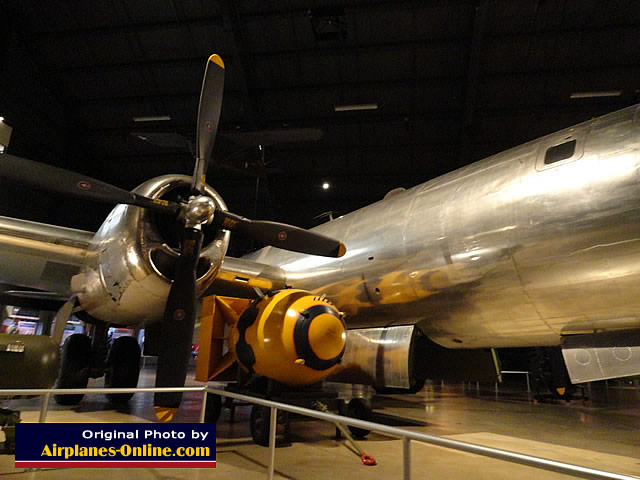 |
B-29 Superfortress "Bockscar" S/N 44-27297 in Dayton, Ohio |
 |
Left nose view of the B-29 Superfortress "Bockscar" showing four black "pumpkin" bombs, and one red "Fat Man" atomic bomb |
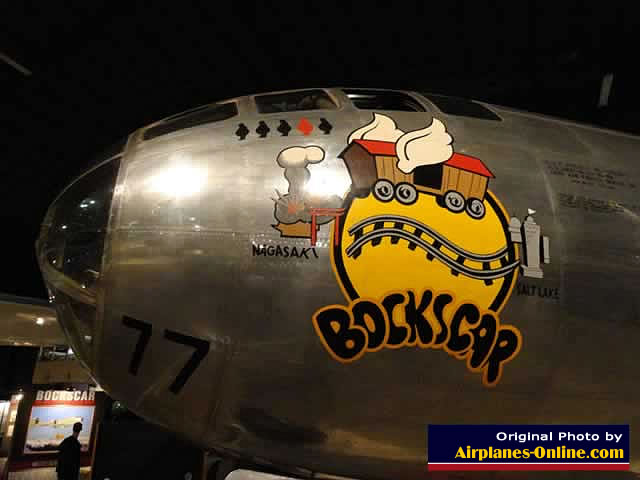 |
Bombadier position in B-29 Superfortress "Bockscar" at Wright-Patterson Air Force Base |
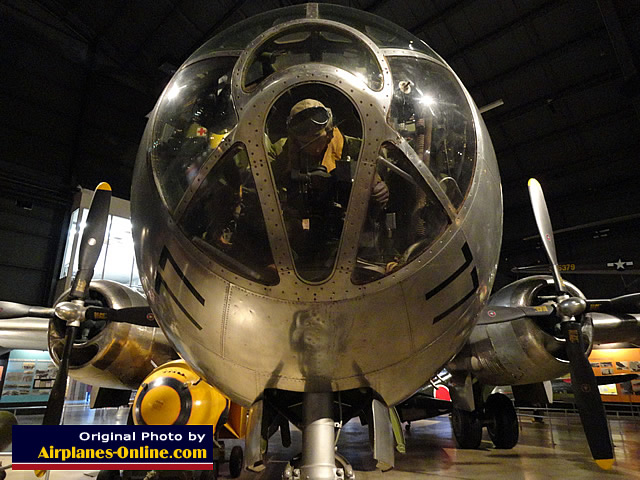 |
B-29 Superfortress "Bockscar" Nose Art ... Salt Lake to Nagasaki |
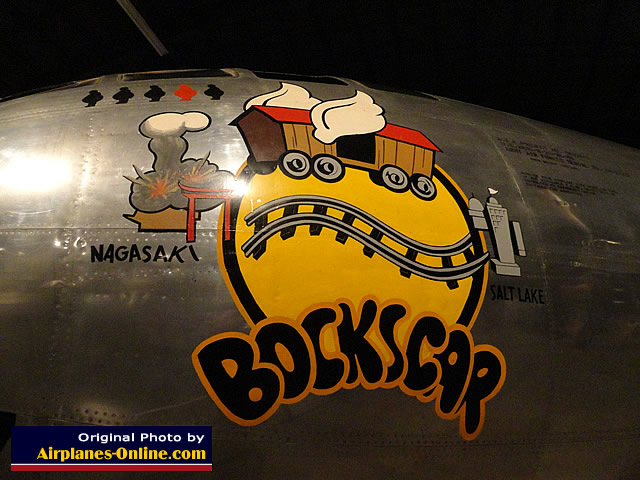 |
B-29 Superfortress "Bockscar" rear fuselage view |
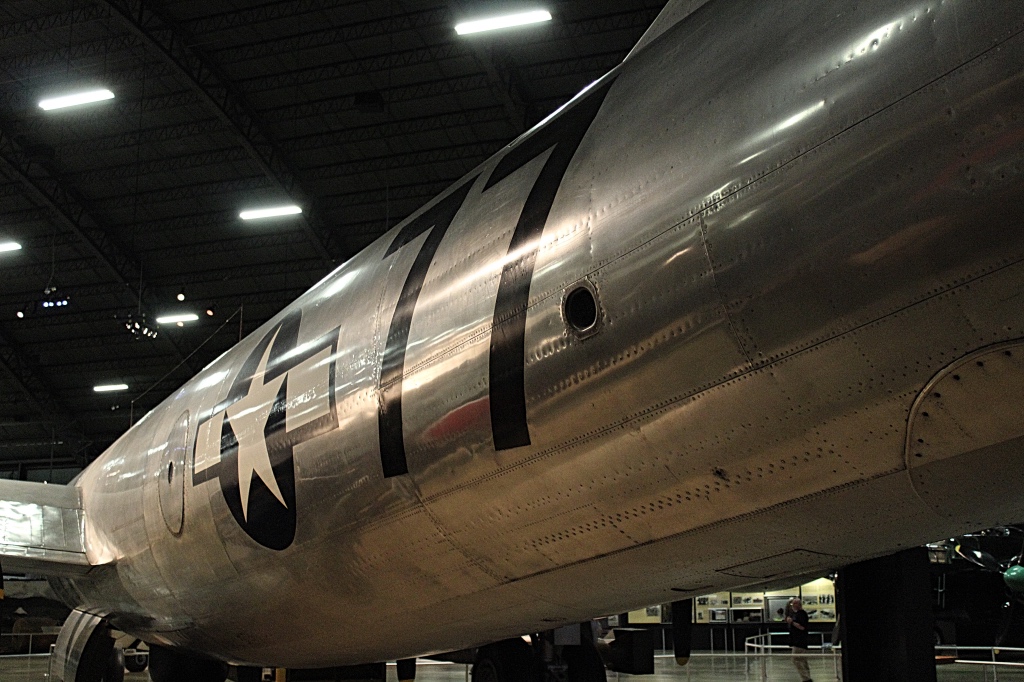 |
B-29 Superfortress "Bockscar" tail section, Wright-Patterson AFB, Ohio |
 |
More about the B-29 Superfortress |
|||||

